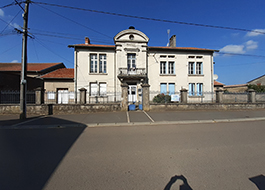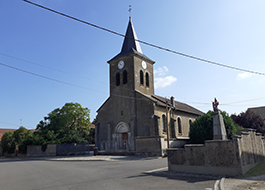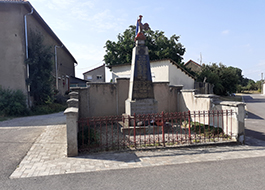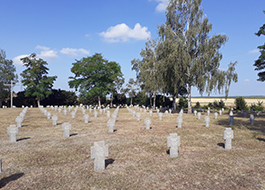Amel-sur-l’Étang
Durée visite : 30 minutes
Moyen : Pédestre
Un domaine gallo-romain prospère sur plusieurs centaines d’hectares. Au Xe siècle, le comte de Verdun cède le village à l’abbaye de Gorze. Son prieuré devient l’un des plus riches de la région. En 1336, Edouard, comte de Verdun, bénéficie de l’aide des Amellois pour écraser ses sujets rebelles. En 1591, le pape transfère Amel aux jésuites de l’université de Pont-à-Mousson. Le prieuré est, dés lors, un domaine agricole et un centre de repos pour frères malades. Il est vendu en 1796 comme bien national.
A Gallo-Roman estate prospered over several hundred hectares. In the 10th century, the Count of Verdun ceded the village to the Abbey of Gorze. Its priory becomes one of the richest in the region. In 1336, Edouard, Count of Verdun, benefited from the help of the Amellois to crush his rebellious subjects. In 1591, the Pope transferred Amel to the Jesuits at the University of Pont-à-Mousson. The priory is, from then on, an agricultural domain and a rest center for sick brothers. It was sold in 1796 as national property.
Auf mehreren hundert Hektar gedieh ein gallo-römischer Besitz. Im 10. Jahrhundert trat der Graf von Verdun das Dorf an die Abtei von Gorze ab. Seine Priorat wird zu einem der reichsten der Region. 1336 profitierte Edouard, Graf von Verdun, von der Hilfe der Amellois, um seine rebellischen Untertanen zu vernichten. 1591 versetzte der Papst Amel zu den Jesuiten an der Universität von Pont-à-Mousson. Das Priorat ist fortan ein landwirtschaftlicher Besitz und ein Ruhezentrum für kranke Brüder. Es wurde 1796 als Staatseigentum verkauft.

Mi-tranché mi-taillé en chef de gueules à un butor étoilé essorant d’or tacheté de sable et à la gorge d’argent, et d’azur à un chevron versé d’argent mouvant de la partition et à un casque de centurion romain d’or, le tout accosté de deux bars adossés du même.
Armoiries composées par Robert André LOUIS et Dominique LACORDE adoptées le 11 décembre 2020.
Half-cut half-cut in chief Gules to a bittern wringing Or mottled Sable and a throat Argent, and Azure to a chevron poured Argent moving from the partition and to a centurion’s helmet gold bar, all accosted by two backed bars of the same.
Coat of arms composed by Robert André LOUIS and Dominique LACORDE adopted on December 11, 2020.
Halb geschnitten, halb geschnitten in Häuptling Gules zu einer Rohrdommel, die wringt oder gesprenkelt ist, und einem Kehlsilber, und Azurblau zu einem Chevron, der Argent gegossen hat, der sich von der Trennwand und zu einem Goldbarren des Helms eines Zenturios bewegt, die alle von zwei unterstützten Stäben derselben besetzt sind.
Wappen von Robert André LOUIS und Dominique LACORDE, angenommen am 11. Dezember 2020.
Les points de visites
.
Détruit pendant la Grande Guerre, la mairie est rebâtie en 1920. Son architecture est caractéristique du style de la reconstruction. Un classicisme certain accompagne les nécessités pratiques.
Destroyed during the Great War, the town hall was rebuilt in 1920. Its architecture is characteristic of the style of reconstruction. A certain classicism accompanies practical necessities.
Im Ersten Weltkrieg zerstört, wurde das Rathaus 1920 wieder aufgebaut. Seine Architektur ist charakteristisch für den Wiederaufbaustil. Ein gewisser Klassizismus begleitet praktische Notwendigkeiten.
.
.
Bâtie par l’évêque de Verdun en 1782, saint-Martin est amputée en 14-18. Les Allemands ne voulaient pas que les clochers, visibles de loin, des églises servent de repère aux militaires français, et notamment à leurs artilleurs.
Built by the Bishop of Verdun in 1782, Saint-Martin was amputated in 14-18. The Germans did not want the bell towers, visible from afar, of the churches to serve as a landmark for the French soldiers, and in particular for their gunners.
Saint-Martin wurde 1782 vom Bischof von Verdun erbaut und zwischen 14 und 18 amputiert. Die Deutschen wollten nicht, dass die weithin sichtbaren Glockentürme der Kirchen den französischen Soldaten und insbesondere ihren Kanonieren als Orientierungspunkt dienen.
.
Le Monument aux morts d’Amel-sur-l’étang compte quarante personnes : trente-deux tuées en 14-18 et huit en 39-45. Cinq femmes sont inscrites sur le monument, dont 4 décédées lors de la guerre de 14-18. La majorité des civils sont morts dans des camps, en Allemagne. Ils y avaient été évacués dés 1914. La Reichwehr voulait plus se débarasser de bouches inutiles, voire de rebelles potentiels, que les protéger. L’obélisque évoque ceux qui ornaient les tombes des cimetières. Il est surmonté du traditionnel coq gaulois.
The Amel-sur-l’Étang War Memorial has forty people: thirty-two killed in 14-18 and eight in 39-45. Five women are inscribed on the monument, including 4 who died during the war of 14-18. The majority of civilians died in camps in Germany. They had been evacuated there in 1914. The Reichwehr wanted to get rid of useless mouths, even potential rebels, more than to protect them. The obelisk evokes those that adorned the tombs of cemeteries. It is surmounted by the traditional Gallic rooster.
Das Kriegerdenkmal von Amel-sur-l’Étang hat vierzig Menschen: zweiunddreißig getötet in den Jahren 14-18 und acht in den Jahren 39-45. Auf dem Denkmal sind fünf Frauen eingeschrieben, darunter 4, die während des Krieges von 14-18 starben. Die Mehrheit der Zivilisten starb in Lagern in Deutschland. Dorthin waren sie 1914 evakuiert worden. Die Reichswehr wollte nutzlose Mäuler, auch potentielle Rebellen, mehr loswerden als sie schützen. Der Obelisk erinnert an jene, die die Gräber der Friedhöfe schmückten. Es wird von dem traditionellen gallischen Hahn überragt.
.
Ce cimetière militaire allemand date de 1916. Il recueillait les dépouilles des blessés, morts dans l’hôpital de campagne installé à proximité. 2284 hommes y reposent.
This German military cemetery dates from 1916. It collected the remains of the wounded, who died in the nearby field hospital. 2284 men rest there.
Dieser deutsche Soldatenfriedhof stammt aus dem Jahr 1916. Er sammelte die Überreste der Verwundeten, die im nahe gelegenen Feldlazarett starben. 2284 Männer ruhen dort.









